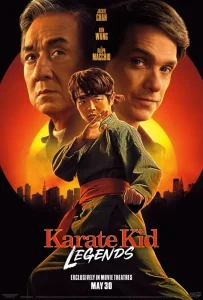 The Karate Kid Is Back
The Karate Kid Is Back
On May 30th the movie, The Karate Kid: Legends, opens in theaters nationwide, approximately 40 years since the original The Karate Kid movie.
The Karate Kid spawned two sequels, then a third with Hillary Swank as a female karate kid, a remake in 2010 with Jackie Chan as the wise Kung Fu master, and a six-season TV series called Cobra Kai that continued the story of the main characters from the original movie while adding a new generation of karate kids.
“Legends” refers to the continuation of the original story and introduces yet another kid to merge the teachings of Mr. Miyagi’s Karate and Mr. Han’s Kung Fu, but..
What Has Been The Legend of The Karate Kid Movie in the Real World?
Bruce Lee’s movies in the 1970’s led to The Kung Fu Craze, which was also helped but the Kung Fu television show.
Lee’s movies featured adult actors and were targeted to an adult audience.
While Kung Fu followed a Chinese immigrant through the American West, it introduced the idea of a child learning martial arts through flashbacks of young Kwai Chang Caine receiving valuable life lessons and philosophy from his blind Master Po.
The majority of the scenes with the young martial artist were question-and-answer type of dialogues that the audience would see manifested in the conflicts the adult Caine would face and eventually overcome in the episode.
The basic formula was to show the child learning the lesson and the man applying it (usually by Kung Fu-ing the bad guys).
It wasn’t until 1984’s The Karate Kid movie that mainstream audiences would see this combination of martial arts philosophy coupled with the young student using physical martial arts to defend himself and to fight off the bad guys.
This is what young audiences were waiting to see while watching Kung Fu on TV.
I know I was.
One critic at the time referred to The Karate Kid as “Rocky with teenagers.”
Just as Bruce Lee et al created the demand for Kung Fu training in the 1970s, The Karate Kid created a demand from an entirely new demographic, children who wanted to learn martial arts.
A Culture Clash
The Karate Kid was about to create a clash of cultures, two different culture clashes, actually. The first clash was that martial arts schools at the time were populated by adult teachers and adult students who took training seriously.
Now, an army of children were banging down the front doors demanding to be the next Karate Kid.
In addition, most of the teachers at these schools learned martial arts while in the military, and under military discipline and command structure.
Suddenly, they had to teach classes full of civilians.
In many ways, this had all the makings of a disaster.
I begin training around this time, when I could either hang with the adults or wait until I was “more mature” to take class with them. It was a much different time.
The prevailing view when it came to children was much more “shut up, listen to your elders, and take whatever we give you” than it was nurturing young minds.
Not just in the martial arts schools, but in society; this was the “I’ll give you something to cry about” era.
Two Major Differences Between Military and Civilian Training
The military recruits, the students learning martial arts on or off their military bases, were all adults, eighteen and older — there were no seven-year old kids.
All of the instructors were used to adults training adults, not worrying about developmental issues and teaching age-appropriately to children.
Coupled with the dynamic of all-adult training, the unique aspect of learning martial arts in the military is this — you can’t leave.
Once you’re in the military you are subject to whatever the higher ranks demand of you, and all you can say is, “Yes, sir.”
There is no excuse for lack of motivation, or feeling bad because of the instructor yelled at a cadet, or giving up because you are bored and not having fun.
As a result, the training could be as brutal and as unrelenting as the instructors would like to make it.
And, when Asian teachers taught American GIs they were particularly brutal due to them being foreigners. It was commonly said that a Black Belt was just someone who could take beating after beating and stick around long enough to be awarded the belt. This was how the Americans earned the respect of the Asian teachers and fellow students.
The First Wave of Karate Kids
This initial onslaught of eager Karate Kids ran headlong into this world of traditional, militaristic training, and while school boomed for awhile grim reality set in.
Many of these teachers were not equipped to teach civilian children martial arts in the way the fictional Mr. Miyagi did.
Most schools were more Cobra Kai than Miyagi-Do.
The evil karate teacher, Kreese, was even portrayed as a Vietnam veteran in the movie, pointing to this dynamic.
Schools had to change out of necessity because, lo and behold, when they treated children like army recruits the kids did the most logical thing, they quit.
I personally watched youngster after youngster drop out due to the strict, rigid, and compassionless nature of the training.
It took roughly a generation of young students to face this training gauntlet and survive long enough to mature into teachers themselves and to eventually change this old paradigm.
Miyagi-Do and Cobra Kai Both Excel and Continue Their Rivalry
Once teachers learned how to teach children, young students came to dominate schools and make up most of their student body because of the Lifeskills training they were taught.
Schools were finally delivering on the promise of what was at the heart of the Karate Kid movie and what made it such a cultural phenomenon — the wise, compassionate master mentoring a young student and the relationship they fostered.
As martial arts became known as “something for kids,” its opposite inevitably arose to take even greater prominence on the world stage.
The UFC and the rise of “ultimate fighting” appealed to young adults, mostly male, eager to prove themselves and a new Mixed Martial Arts revolution took place.
Now, any training that was less-than-lethal was referred to as being a McDojo, an allegedly fake school devoid of value compared to these new tough guys.
To be fair, many schools followed the Self-Esteem Movement in the 1990s where making kids feel all-good, all the time, took precedence over lessons of work and reward, and learning to face and overcome challenges to earn one’s place.
Just as grade inflation took over academic schools, belt inflation took over martial arts schools and created a generation of paper tigers.
As the pendulum swung too far into inflated self-esteem with deflated skills, it also swung too far into the purely physical.
The heart of The Karate Kid was cast aside in favor of the mindset of “The Alpha Male” and the multi-billion dollar prize-fighting industry it produced.
A kickboxing instructor shot to death after running down a car theft, while still wearing his boxing gloves; a Jiu-Jitsu master having his friends hold down a teenage homeless boy while he punches him and nearly breaks his wrist for heckling the teacher’s daughter; UFC champions convicted of spousal abuse and rape; novices choking friends to death because they don’t understand the dangers of inducing unconsciousness; children entering cage matches getting bloody and bruised; and bumper stickers that read, “my kid can choke out your honor student,” are just some examples of the effects of this mentality of pure physical power devoid of character education.
Cobra Kai was reborn and looks to be here to stay.
The Hopeful, Perennial Legend of The Karate Kid
Martial arts, historically, was shrouded in mystery and not taught to just anyone and it derived power from this air of esoteric knowledge and skill.
This illusion was shattered after martial arts became popularized and people began testing various systems.
The main benefit of testing out martial arts has been to eliminate the nonsense and stage-performance aspects and pare the arts down to more practical applications with modern training methods.
This deconstructing of martial arts into the most readily-applicable moves and eliminating the philosophy of traditional training, unfortunately, has devolved martial arts into a survival-of-the-fittest dynamic where only the physically strong survive to lord their prowess over lesser beings, mostly on social media.
This trend of pure fighting ability represents life out of balance, and as Mr. Miyagi so eloquently stated,”balance is key.”
Even when Daniel had to physically fight in the tournament and was worried if he could win, Miyagi told him,”win, lose, no matter.”
What mattered was the person Daniel became through his martial arts training.
If anything, the legend of The Karate Kid has been, and will continue to be, the promotion of a balanced character, self-mastery, and overcoming one’s own violent tendencies and the need to fight while striving to learn to defend oneself, ultimately making for a kinder world.
I just hope the new movie retains the heart of what made it, and martial arts, so special.
